METHODS
/ PROCESS
/ MATERIALS
Throughout Unit 3, I maintained a strong sense of curiosity and experimentation in my material-and-process driven studio and workshop-based research. My methods, processes and materials initially focused on developing artworks and display strategies that became my Summer Show installation. Based on feedback from the show, I continued my practice-based and contextual research, expanding my methods, materials and introducing some new ideas over the summer break. Participating in a summer school in Berlin allowed me to expand on some of my processes in response to site, mobility, and location. Back in the studio I continued to develop and document further iterations of my research. Alongside this, I engaged in a range of creative pursuits such as art talks, presentations, and workshops to explore how my research could operate publicly beyond the exhibition format. I approached Unit 3 this way to keep developing and experimenting without interruption, and to secure a smooth transition from academic study to professional practice. This approach allowed me to further refine technical and theoretical dimensions of my research in direct dialogue with feedback and contexts.
1. Display Strategies
tables / seats / hooks / panels
I began exploring display strategies, like my artworks, drawn from the domestic space. My focus was on this idea of support and how everyday furniture like kitchen tables perform as central gathering points. In my Mother’s house, the table was where we dined, studied, learnt and met as a family. For me it acted as a functional object as well as being symbolic. This idea prompted me to think about how functional forms can be reimagined as containers of memory and belonging.
I started designing and fabricating furniture-like functional objects such as tables, seats, hooks, panels that embody collapsibility, mutability, and mobility, ultimately wondering about the body’s structural features that support movement and connection. By making tables and seats collapsible and on wheels, I charged them with potential energy, as if they were always waiting to morph, and move with ease. My material choices were equally intentional. I chose mild steel for its structural strength yet vulnerability in tendency to rust with time, similar to the skeleton of a house or the body; pine for its scent and deep personal connection to my childhood home. Hooks became joints, panels a kind of skin, each element speaking its own material language of support, protection, and memory. I developed these display structures as artworks in their own right, holding, encompassing, and conversing with what they present.
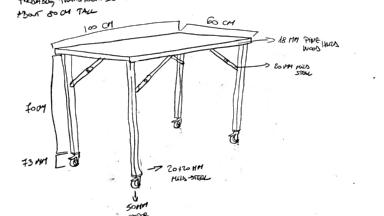
Initial Sketch
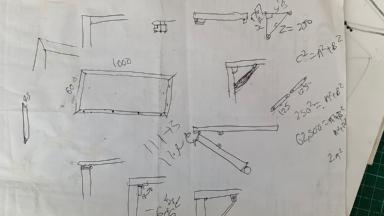
Table mechanics seketch
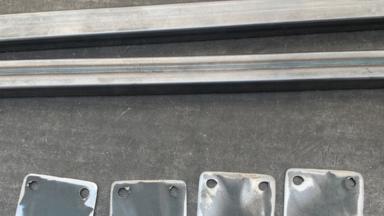
Plasma cut mounts
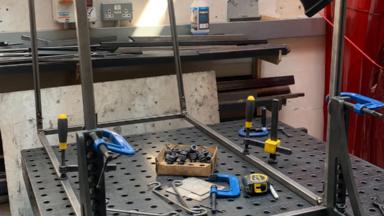
Table frame weld
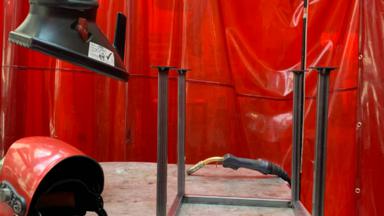
Seat frame weld

Pine table top install
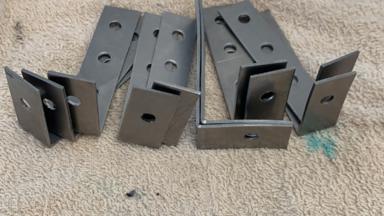
Bracket fabrication
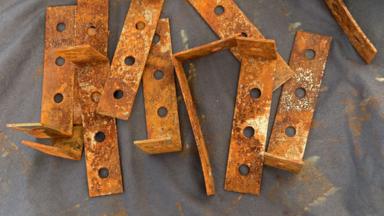
Rusted brackets
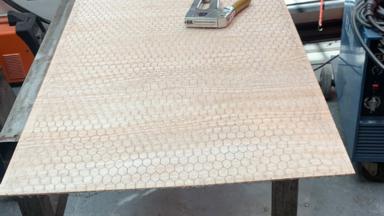
Panel preparation
2. Fire as sustenance
visceral trace / force of continuity / preservation
My use of fire emerged as both a conceptual and material force within my research, developed in response to feedback during a group crit that the table lacked a sense of time and trace of memory. The table I had presented, with its newly made pine surface and fresh steel frame, appeared too pristine, detached from the passage of time. In response, I began to explore ways of inscribing duration and transformation into the materials. This led me to the process of charring wood and rusting steel, gestures that physically record time through material change.
Encountering We Come from Fire and Return to Fire (2024) by Otobong Nkanga, further shaped this direction. In Nkanga’s work, fire operates as both a destructive and reparative force, a means of renewal, sustenance, and transformation. Inspired by this, I began charring pine wood whose scent, grain, and charred surface, summoned my childhood home built, furnished, and heated with pine. Fire, in my practice, functions as a visceral trace and a ceremonial passage of return. It purifies, preserves, and encompasses continuity, acting as a transformative medium between past, present, and future.
The resulting charred table, seat, and panels are acts of preservation that hold memory much like food once stored through charring in traditional Hungarian practice. In this way, memory and home become sustenance; stored, protected, and awaiting return. Fire thus becomes an active presence in my practice that transforms display structures into containers of time, emotion, and continuity, where the past is both held and carried forward.
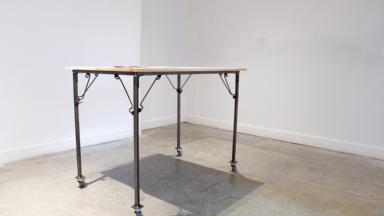
Table prototype

Charring the table top
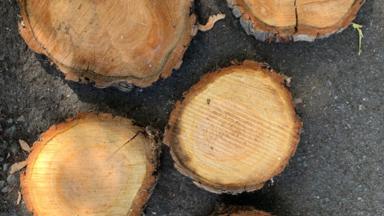
Raw pine cuts
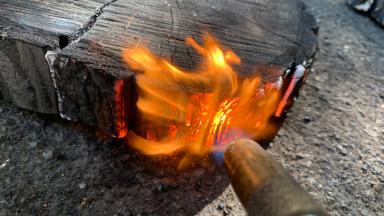
Charring pine cuts
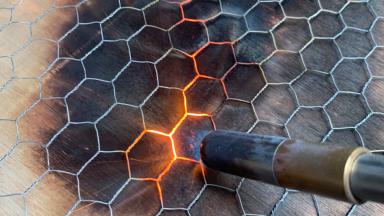
Charring pine wood panels
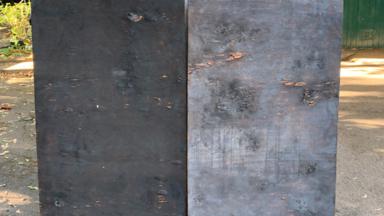
Charred pine panel
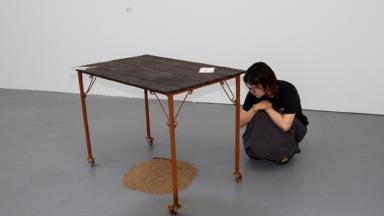
Final table install
3. Embracing Accidents
materiality / accidents / agency
For the Summer Show my original plan was to cover the wall with mud and hay, supported by wooden panels and chicken wire, with my etched glass suspended in front like a memory imprinted in my mind’s eye. This combination was meant to anchor the work while allowing them to linger against a textured, earthy surface. However, during a crit, peers remarked on the compelling materiality of the bare panels like their surface, weight, and thickness. In response, I decided to abandon the original covering and instead charred the panels, echoing my treatment of the tabletop.
Leaving the chicken wire during charring, produced velvety tones of black, brown, and purple, which for me hinted on cosmic skies or deep oceans. At that moment it felt wrong to conceal this accidental beauty. During installation however, the wire clashed visually with the etched and woven glass, so I decided to remove it to allow the work and the panel to coexist without dissonance.
Initially, embracing these accidents was unsettling, but it became deeply rewarding. This process taught me to listen to the materials’ own language and give them agency. Viewers sensed the surface viscerally, even describing imagined smells of a sweating horse’s skin. It also revealed how display methods can alter or intensify the reading of the work, and when done with sensitivity, they enhance its presence and quality.

Processing pine panels
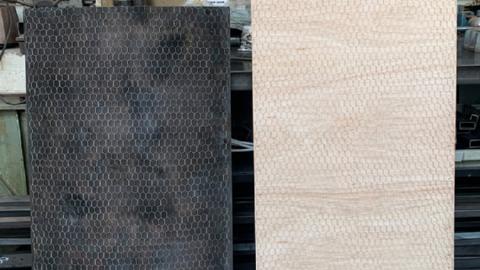
pine panels, before and after
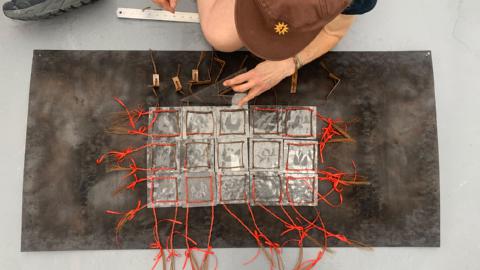
glass installation, trial and error
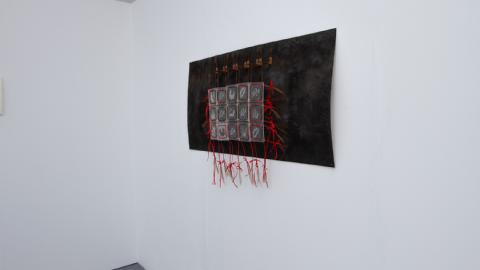
etched glass, final install
4. Process-driven awareness
co-opting materials / body as material / immaterial / material as mediator / material tensions
Throughout my MA I become increasingly curious about the materiality and meaning of my work, exploring how materials carry memory, emotion, and presence. For the Summer Show, I selected five of my works that while each significant individually, collectively formed the installation the House is the Body, the Body is my Home.
Transferences – co-opting materials
This project investigates hybrid print-sculptures, co-opting materials and processes from both sculpture and printmaking that fuse printmaking gestures and materials with sculptural language. Developed in Unit 2, this series of etching embossments explore the interplay of material, memory, and the body. Responding to techniques I learnt in the etching workshop, I worked contemplatively with needle and acid, producing serial, inkless embossments where paper becomes the skin of my body, inscribed with memories of home and belonging.
For the Summer Show, I experimented with an unframed, magnet-mounted presentation. This allowed the works to extend beyond flatness, where the tear, thickness, and surface of the paper, along with the half-a-millimetre delicate embossments, emerge as low-relief sculptures. These forms blend two- and three-dimensional qualities, like memories coming alive, almost there but not quite. They resemble inkless tattoos emerging from my skin, as visceral traces of home and belonging.
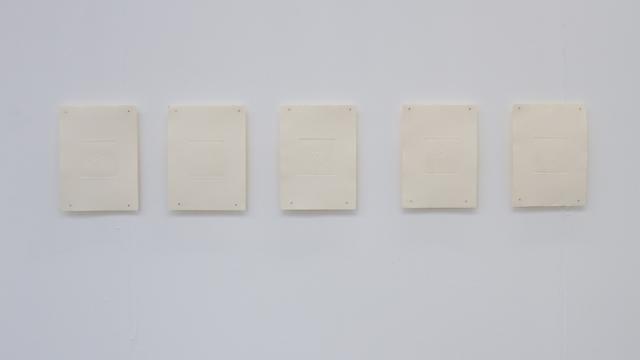
magnet mounted embossed cotton paper
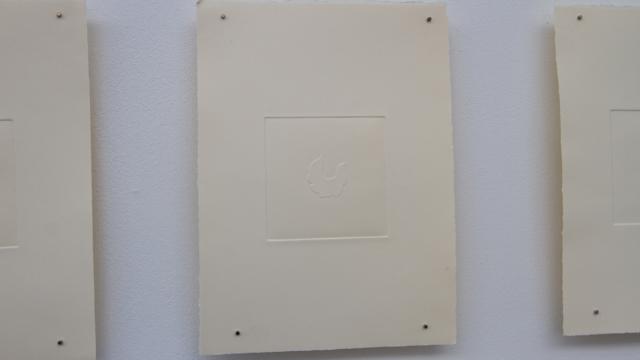
Detailed embossed cotton paper
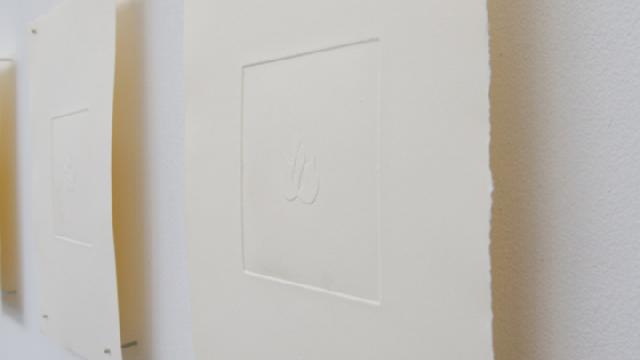
Detailed embossed cotton paper
Weave of me – body as material
This miniature sculpture was completed in Unit 2, and during Unit 3 my aim was to find an effective way to present it. The Summer Show provided an amazing opportunity to test my ideas publicly.
Inspired by Mona Hatoum’s delicate hair works, this piece explores the interlocking relationships between body, home, house, and landscape. By investigating the body as sculptural material, I use my own hair as trace and archive of presence, reflecting on how the body becomes a container that houses and sustains existence. I weave fragmented motifs from my Mother’s embroidery, originally inspired by the fields surrounding our home, into silk-paj, a delicate, shifting textile that mirrors the fleeting and elusive nature of memory. The sculpture seeks to reveal a sense of continuity between self and the body, body and house, and house and landscape, tracing how each hold and reflects the other.
The presentation of this sculpture challenged me deeply. Its lightweight nature and the fine almost invisible threads of hair meant it could be easily disturbed by the slightest movement of air. Ultimately, I chose to emphasise this sense of motion by positioning the piece in the corner of my table, at a point where it was almost falling off the edge. This created a visual tension, as if the work was always on the verge of disappearing, responsive to movement, and mirroring the emotional precarity and vulnerability of self, home, memory and belonging.
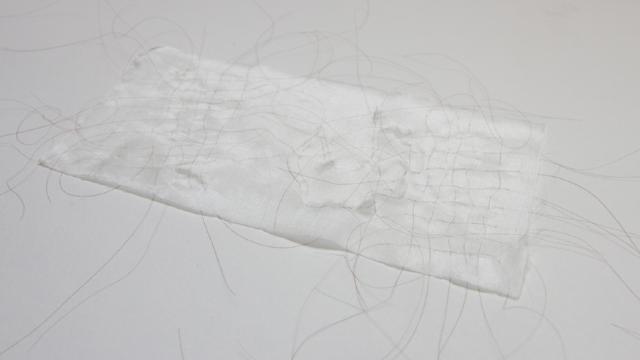
Silk-paj woven own-hair
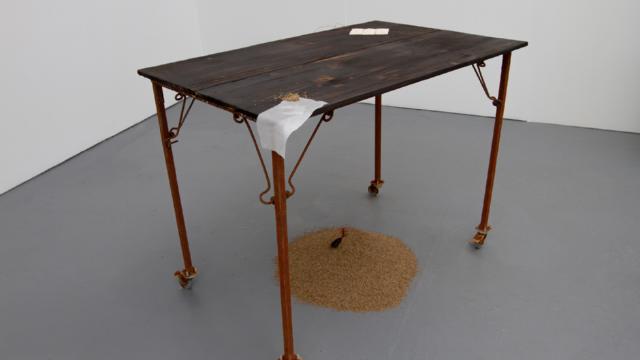
Final installation of woven hair

Closeup of final install
Unfinished ceramic works – immaterial
I wanted my ceramic works to remain unfinished. In Unit 2, I made one hundred press-moulded ceramic tiles, each slightly different, using white stoneware clay: precious, earthy and fragile when kilned like bone, to inscribe the fragmented patterns of my Mother’s embroidery that once mirrored the landscape surrounding our home. These tiles become a container for memory, embodying the sense that my own bones carry these connections to my Mother, my home, and the land itself. I began joining them into small scale, talismanic objects that I could carry with me, embedding ritual and movement into the work.
In Unit 3, I decided to weave and un-weave the pieces repeatedly, responding to Mona Hatoum’s use of weaving as a compulsive activity, a way of passing time and creating form from almost nothing. I realised I didn’t want to finish the work; I just wanted the forms, objects, and surfaces to exist in pieces, so I could use the act of doing and undoing as a way of waiting, of longing for return.
For the summer show, I placed an unfinished weave at the edge of my table, opposite the hairwork. I wanted it to feel like I had just stepped away, leaving the work in a state of pause. This decision helped me understand how placement can create spatial tension, and how unfinishedness can be a powerful element. I learnt that weaving can be a way of holding the immaterial: time, memory, and emotion without needing resolution.
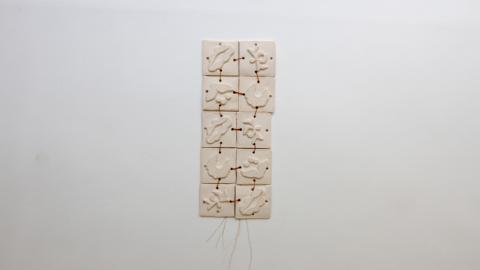
Stoneware ceramic weave experiment 1

Stoneware ceramic weave experiment 2
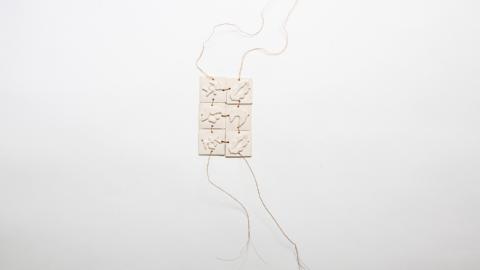
Stoneware ceramic weave experiment 3
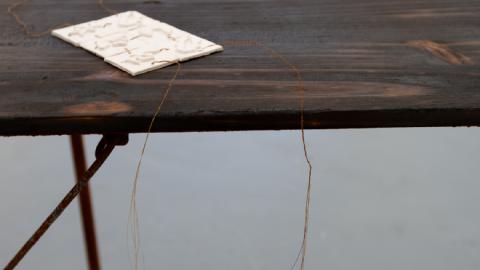
Stoneware ceramic weave final install
Etched glass weave – material as mediator
In this project, I turned to glass as a stand-in for the lens of the eye, that mediates between the self and the cosmos, etched with memories of my Mother’s embroidery motifs. As a child, I looked out from the safety of our home, observing fields and flowers reflected in her stitchery. In this work, I look inward, tracing those forms to explore home as interlocking in the body, the house, and the landscape.
Initially, I planned to embed the glass pieces into a seat I fabricated, placing it nearby my table. I was thinking about furniture as vessels of memory, comforting the body, and charged with emotional weight. I wished to offer a resting place for these memories.
However, I realized the placement directed the gaze downwards, which felt limiting. Embracing the accidental discovery of the charred panels, I shifted to suspension, hanging the work at eye-level. I was very pleased with this presentation, as it transformed the meaning of the work. The piece began to look inward and outward simultaneously, toward the cosmos. It became both visceral and expansive, a reflection of how my mind’s eye through memory can mediate between the self and the cosmos.
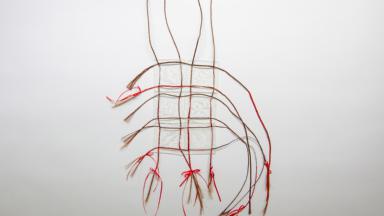
Etched glass weave

Preparing to etch glass
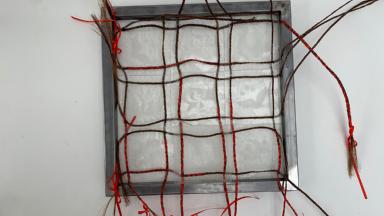
Glass install experiment 1
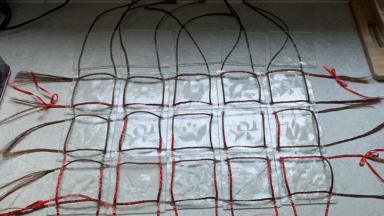
Glass install experiment 2
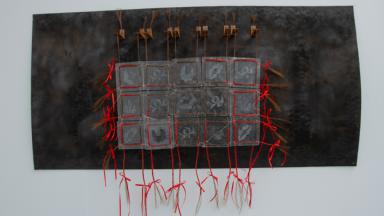
Etched glass final install
Braid on caraway seeds - Material tensions
Throughout this project, I explored how different materials and methods of presentation could create material dialogues and tensions within my installations. In Unit 2, I braided human hair with satin ribbons, recalling my Mother’s hand braiding my hair, a ritual of tenderness that I translated into a sculptural language, encapsulating emotional weight, memory, and care.
In early Unit 3 I struggled to find an effective way to present these braids, and living materials. I experimented with various arrangements on the table I built, and even considered photography. However, during a tutorial, Matthew questioned whether a photograph could convey the material presence of the braid to an audience. This was a turning point that led me back to the physical installation.
For the Summer Show, I resolved this struggle by finding a way to place a single braid of human hair on a pile of caraway seeds beneath the table, as a ritual offering. Introducing the caraway seeds sparked a material dialogue that allowed me to stimulate a domestic temporality, that connects sensory memory with gestures of proximity and care. The feedback from Sarah Woodfine confirmed, that this configuration produced a palpable material tension, and slowed sense of time. I learnt that sensitivity to materials and thoughtful consideration of presentation can open a meditative space for the audience with deep psychological resonance.
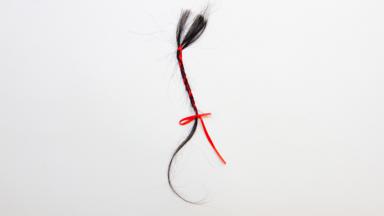
Braided hair with satin ribbon
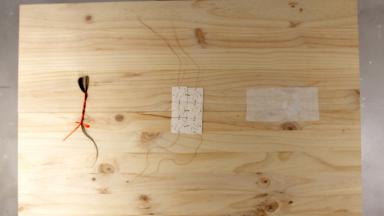
Presentation method test 1
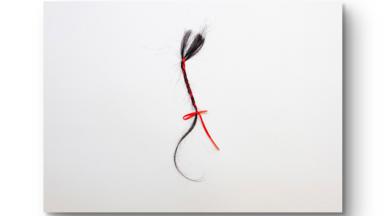
Presentation method test 2
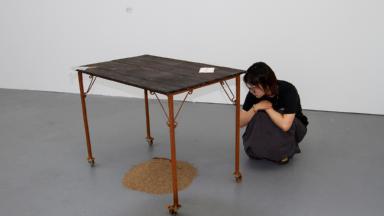
Final install
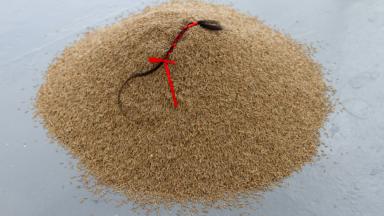
Final install detail
5. Installation
transfiguration / curation / collaboration
For the installation of my works, I selected a corner space in Room A501, shared with MA Sculpture and MA Photography students. Working with this corner allowed me to emphasise my curiosity in circularity and roundedness, using the site as a point of convergence where past, present, and future align. I wished to transfigure the cubic architecture of the room into something more rounded and ceremonial, like an embracing outline that enveloped the body of the viewer as they moved through the space. By approaching it this way, I intentionally handed over the choice of encounter to each viewer, allowing them to navigate freely, shift between distance and closeness, and trace their own sensory and spatial journey through the layers of the work.
Initially, the installation process felt overwhelming. Moving all elements of my work into the space was chaotic, with too many fragments scattered around. However, through careful thinking, I worked with elevation from floor, to table hight, to eye level and crafted a multi-layered installation that gradually unfolded in space and time. Through this process, I gained a deeper understanding of how spatial relationships can alter the way a work is perceived and experienced.
The final curation of the room emerged through a collaborative process that aimed to create a balanced, spacious, and evocative layout. Our curatorial decisions stimulated some meaningful dialogues between the works. For instance, the placement of my installation near Bea Underwood’s work, highlighted our shared interest in domestic materials and notions of containment, each expressed through distinct formal languages. In this way collaborative curation became an integral part of our sculptures and installations, transforming the space into a living dialogue between objects, people and the room itself.
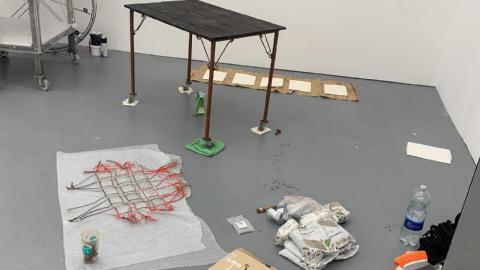
Prep, install, chaos
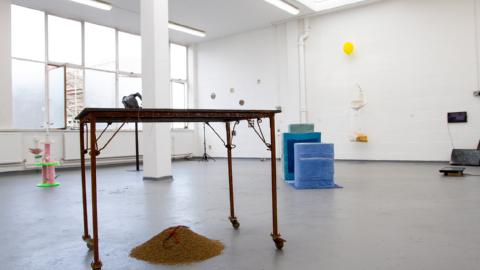
Final Installation
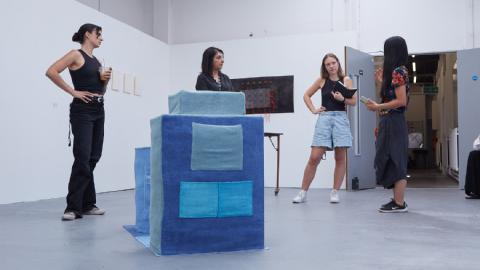
Final installation, group crit
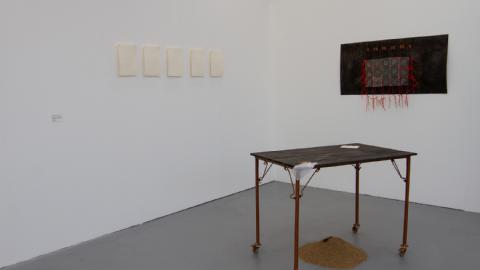
Post install
6. Configure and reconfigure
form / experimentation / meaning
During deinstall of the Summer Show, I used my time proactively to experiment with configuration and reconfiguration of my works, creating an image archive I can revisit later. Over the summer, I also managed to complete my seat, which allowed me to test ideas through multiple iterations. For the seat, I left the pine in its raw state, only burnt to release its scent and preserve its natural cracks and rings. The uneven surface of the seat, introduced a grounding tension exploring links between the body, house, and the landscape. I wished to use this process to map the possibilities of how my work can shift and be reformed, and how might it evolve beyond my time at Camberwell.
This method of configuring and reconfiguring deepened my material exploration, letting me freely and playfully shift positions, orientations, and relationships between elements. These changes uncovered new meanings, reflecting on my interest in transformation, fragmentation, recollections, movement and mobility, and process-driven approach to sculpting.
Material experiments image archive
7. Assemblage on the go
sculptural diary / site-specificity / ephemerality
In August, I took part in the Shared Campus International Summer School in Berlin, responding to the Berlin Biennale’s theme on fugitivity. Rather than keeping a written diary, I decided to create Humble Shelters. Five small, ephemeral sculptures, assembled from found remnants such as chewing gum, wood chips, beer bottle caps, strands of my own hair etc. I wanted to transform everyday debris into a material diary of my movement through the city, reactivating my childhood instinct to build imagined worlds from discarded matter. These works were presented momentarily in public and semi-public spaces, existing only briefly and recorded with my phone’s camera.
During this process, my studio became what my two hands could hold. Working intuitively, iteratively and often at night, I built fragile constellations that mirrored Berlin’s shifting rhythms. Using my hair as a connective element made the act of joining deeply personal, embedding traces of the body within the work. This experience challenged and expanded my understanding of material dialogue; how site and circumstance shape what and how I make. It opened new possibilities for a more responsive, site-specific sculptural practice, where making becomes both record and reflection. You can read more about my summer school experience in my Additional Research – Professional Experiences section.
Humble shelters development process image archive
8. Iterations
responding to feedback / thinking-through-making
Throughout the summer, I continued exploring iterations as part of my practice as a sort of thinning-through-making. During the summer break with the MA Sculpture 25 cohort, we organised Overlay, a self-initiated group exhibition at the Arts SU Gallery. For me, this was an exciting opportunity to respond to feedback from my Summer Show and test new ideas.
It had been advised that the bright, white setting in A501 had flattened the atmosphere of my installation, muting its sensory qualities. In response, I decided to experiment with the Arts SU Gallery’s more intimate space, with lower ceilings and dimmer lighting, by creating an iteration of my etched glass work. I installed scorched pine tiles, covering the entire wall. This iteration expanded the work spatially and emotionally, drawing viewers in and intensifying the works presence. It grown out of the scale of the body and in turn its presence enveloped it.
We decided to curate the work in proximity with Bea’s and Savanna’s works prompting further dialogues between the domestic materials, tactility, olfactory engagements and the body.
Through this, I learnt how subtle shifts in scale, placement, and context transform a work’s presence and meaning and the many ways materials may respond to context and environment. This iterative process of thinking-through-making opened new readings of my work and reinforced the idea that each piece is part of an ongoing dialogue between body, material, and place.
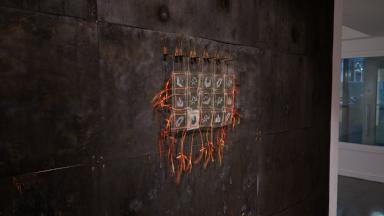
Etched glass install
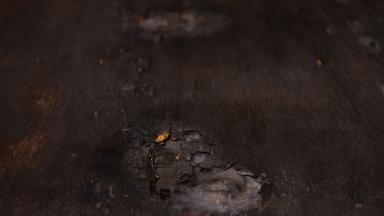
Charred pine detail 1
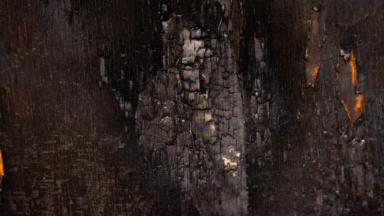
Charred pine detail 2

Charred pine detail 3
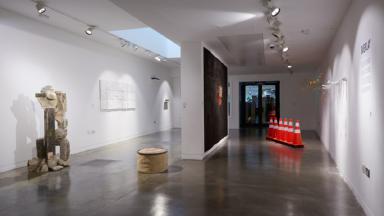
Environmental
9. Interplay of material and form
cyclical time / morph / repetition
During the summer break, I became interested in the notion of cyclical, arboreal time influenced by Giuseppe Penone’s exhibition Thoughts in the Roots (2025) at Serpentine South. Time that turns, returns, and folds back on itself completing circles within circles. In this project, I wanted to capture cyclical time through the interplay of material and form, exploring how the body, as home for the self, might hold and express these rhythms.
I gathered strands of hair accumulated over the summer, my own, my sisters, and horsehair, reflecting on how bodily cycles of shedding and renewal inscribe linear time within a larger cyclical pattern. I shaped these hairs into springs, smaller circles within larger ones. The spring, as a form, stores and releases movement; it becomes a vessel of potential energy, holding linear time folded into cyclical return.
Between September and early October, I used my remaining studio time to document and test methods of presentation, placing the hair springs on the table, the seat and the floor. I wanted to make cyclical time tangible, as a vessel for matter, energy, and lived experience. Placing the hair in dialogue with the charred pine fused body, house, landscape, and time into an interlocking site of becoming. Through this project, I expanded the forms that hold memory and temporality in my work beyond the braids, allowing my research to live, morph, and continue unfolding in new material and spatial expressions.
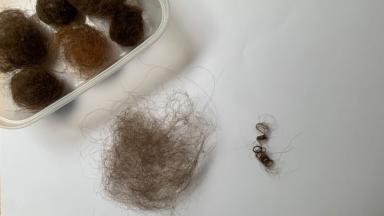
Hair spring development
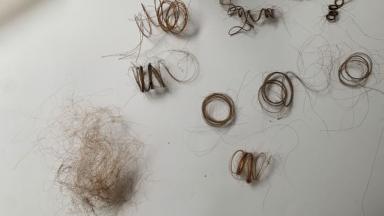
Hair spring experiment
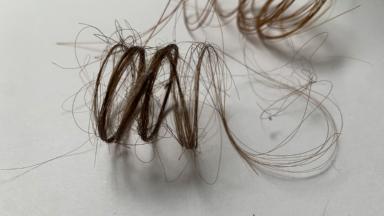
Hair spring detail

Table install
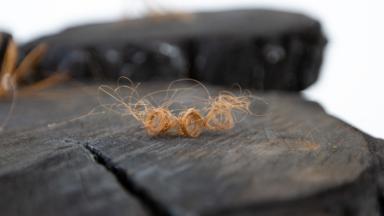
Seat install detail\
